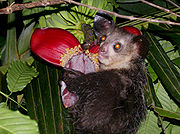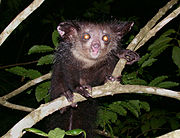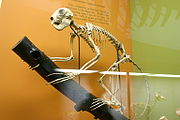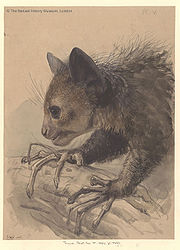
Aye-aye
Background Information
This selection is made for schools by a children's charity read more. SOS mothers each look after a a family of sponsored children.
| Aye-aye | |
|---|---|
 |
|
| An Aye-aye eating banana flowers. | |
| Conservation status | |
|
Near Threatened ( IUCN 3.1) |
|
| Scientific classification | |
| Kingdom: | Animalia |
| Phylum: | Chordata |
| Class: | Mammalia |
| Order: | Primates |
| Suborder: | Strepsirrhini |
| Infraorder: | Lemuriformes |
| Family: | Daubentoniidae Gray, 1863 |
| Genus: | Daubentonia É. Geoffroy, 1795 |
| Species: | D. madagascariensis |
| Binomial name | |
| Daubentonia madagascariensis ( Gmelin, 1788) |
|
The Aye-aye (Daubentonia madagascariensis) is a lemur, a strepsirrhine primate native to Madagascar that combines rodent-like teeth with a long, thin middle finger to fill the same ecological niche as a woodpecker. It is the world's largest nocturnal primate, and is characterized by its unusual method of finding food; it taps on trees to find grubs, then gnaws holes in the wood and inserts its elongated middle finger to pull the grubs out. The only other animals known to find food in this way is the Striped Possum. From an ecological point of view the Aye-aye fills the niche of a woodpecker as it is capable of penetrating wood to extract the invertebrates within.
Daubentonia is the only genus in the family Daubentoniidae. The Aye-aye is the only extant member of the genus (although it is currently classified as Near Threatened by the IUCN); a second species, Daubentonia robusta, appears to have become extinct at some point within the last 1000 years.
Etymology
Among some Malagasy, the Aye-aye is imitatively called "Hay-hay" for a vocalization it is claimed to make. It is supposedly from the European acceptance of this name that its common name was derived. However, the Aye-aye makes no such vocalization. The name was also hypothesized to be of European origin, with a European observer overhearing an exclamation of fear and surprise ("aiee!-aiee!") by Malagasy who encountered it. However, the name exists in remote villages, so it is unlikely to be of European origins. Another hypothesis is that it derives from "heh heh," which is Malagasy for, "I don't know." If correct, then the name might have originated from Malagasy people saying "heh heh" to Europeans in order to avoid saying the name of a feared, magical animal.
Classification
- Order Primates
- Suborder Strepsirrhini: non-tarsier prosimians
- Infraorder Lemuriformes
- Family Daubentoniidae
- Genus Daubentonia
- Aye-aye (Daubentonia madagascariensis)
- † Giant Aye-aye (Daubentonia robusta)
- Genus Daubentonia
- Family Cheirogaleidae
- Family Lemuridae
- Family Lepilemuridae
- Family Indriidae
- Family Daubentoniidae
- Infraorder Lorisiformes
- Infraorder Lemuriformes
- Suborder Strepsirrhini: non-tarsier prosimians
Due to its many derived morphological features, the classification of the Aye-aye has been debated since its discovery. The possession of continually growing incisors (front teeth) parallels those of rodents, leading early naturalists to mistakenly classify the Aye-aye within mammalian order Rodentia.
The Aye-aye's classification with the order Primates has been just as uncertain. It has been considered a highly derived member of the Indridae family, a basal branch of the strepsirrhine suborder, and of indeterminate relation to all living primates. In 1931, Anthony and Coupin classified the Aye-aye under infraorder Chiromyiformes, a sister group to the other strepsirrhines. Colin Groves upheld this classification in 2005 because he was not entirely convinced the Aye-aye formed a clade with the rest of the Malagasy lemurs, despite moelcular tests that had shown Daubentoniidae was basal to all Lemuriformes, deriving from the same lemur ancestor that rafted to Madagascar during the Paleocene or Eocene. In 2008, Russell Mittermeier, Colin Groves, and other others reversed this taxonomic ruling by grouping the family Daubentoniidae within the infraorder Lemuriformes.
Physical characteristics
The Aye-aye is the world's largest nocturnal prosimian, and dwells predominantly in forest canopies. It weighs about 2.5 kilograms (5.5 pounds), with the female weighing in slightly less, at approximately 2.4 kg (5.3 lb). Other than weight and sex organs, aye-ayes exhibit no sexual dimorphism of any kind. They all grow from 30–37 centimetres (12–15 inches) from head to body, with a 44–53 cm (17–21 in) tail.
The adult Aye-aye has black or dark brown fur covered by white guard hairs at the neck. The tail is bushy and shaped like that of a squirrel. The Aye-aye's face is also rodent-like, the shape of a raccoon's, and has bright, beady, luminous eyes. Its incisors are very large, and grow continuously throughout its lifespan. These features contrast its monkey-like body, and are the likely cause of why scientists originally deemed it to be a rodent.
The Aye-aye's hands are arguably its most unusual feature. Much like other primates, it possesses opposable thumbs, but both the hallux and the fingers are long and slender, and appear to be in a curved position somewhat similar to that of a fairy-tale witch when the muscles are relaxed. The middle finger can be up to three times longer than the others.
Gestation for the Aye-aye lasts from 5 to 5 1/3 months. Births can occur at any time during the year, and females often wait 2–3 years between births. The infant takes about 7 months to be weaned, and stays with its mother for two years. The Aye-aye matures quickly; males rarely take more than 1 1/2 years to mature, and females take about an extra year. Lifespan is not known, but the world record is 23 years in captivity.
Habitat
The Aye-aye lives primarily on the east coast of Madagascar. Its natural habitat is rainforest or deciduous forest, but many live in cultivated areas due to deforesting. Rainforest Aye-ayes, the most common, dwell in canopy areas, and are usually sighted upwards of 700 meters altitude. The Aye-aye sleeps during the day in nests built in the forks of trees.
Behaviour
Social interaction
The Aye-aye is classically considered 'solitary', but recent research suggests that they are more social than once thought. It usually sticks to foraging in its own personal home range, or territory. The home ranges of males often overlap and the males can be very social with each other. Female home ranges never overlap, though a male's home range often overlaps that of several females. The male Aye-Aye live in large areas that are up to 80 acres (320,000 m2) while female have smaller living space that goes up to 20 acres (81,000 m2). Regular scent marking with their cheeks, neck and genitals is a way that aye-ayes let others know of their presence and repel intruders from their territory. Like many other prosimians, the female Aye-aye is dominant to the male. The Aye-aye is not monogamous by any means, and often competes with each other for mates. Males are very aggressive in this regard, and sometimes even pull other males off a female during mating. Outside of mating, males and females interact only occasionally, usually while foraging.
After impregnating a female, the male usually stays in close proximity until the infant is born and has matured a bit. The father will sometimes share food with the infant, but otherwise infants' primary source of social interaction is with their mothers. Mothers and infants often wrestle, chase, and play "peek-a-boo" for entertainment. After 13 weeks, infants are usually ready to interact with other young Aye-ayes, usually by play-fighting.
Foraging
The Aye-aye begins foraging anywhere between 30 minutes before or 3 hours after sunset. Up to 80% of the night is spent foraging in the canopy, separated by occasional rest periods. The monkey-like body of the Aye-aye enables it to move vertically with ease. It climbs trees by making successive vertical leaps, much like a squirrel. Horizontal movement is more difficult, but the Aye-aye rarely descends to jump to another tree, and can often cross up to 4 km (2.5 mi) a night.
Infants are fully dextrous within a month of birth. At first they can only climb on a branch hanging upside down, but they gradually work their way up to the various acrobatic feats that adults can perform. Curiously, walking and running on the ground is often hardest for an Aye-aye to master.
Diet
The Aye-aye commonly eats nuts, and also grubs, fruits, nectar, seeds, and fungi, classifying it as an omnivore. It often picks fruit off trees as it moves through the canopy, often barely stopping to do so. An Aye-aye not lucky enough to live in its natural habitat will often steal coconuts, mangoes, sugar cane, lychees and eggs from villages and plantations. Aye-ayes chew a hole into wood and get grubs out of that hole with their elongated and bony middle fingers.
Social foraging
Though foraging is mostly solitary, it will occasionally forage in groups. Individual movements within the group are coordinated using both sound (vocalisations) and scent signals.
History
The original meaning of the name Aye-aye has been lost, as the originating language is extinct. There is a hypothesis that the word "aye aye" signifies simply a cry of alarm to alert others to the presence of this animal, which many Malagasy consider an ill omen.
With D. robusta's extermination, the D. madagascariensis Aye-aye was thought to be extinct. However, it was later rediscovered in 1961. Six individuals were transported to Nosy Mangabe, an island near Maroantsetra in eastern Madagascar. Recent research shows that the Aye-aye is more widespread than was previously thought, but is still endangered.
There are several Aye-ayes kept in zoos. The largest collection of Aye-ayes and the most successful breeding program with a current population of 22 individuals is at the Duke Lemur Centre at Duke University, Durham, North Carolina, US. Several also reside outside of the US at various locations.
Superstition and public controversy
The Aye-aye is an endangered species not only because its habitat is being destroyed, but also due to native superstition. Besides being a general nuisance in villages, ancient Malagasy legend said that the Aye-aye was a symbol of death. It is viewed as a good omen in some areas, however, but these areas are a minority.
Researchers in Madagascar report remarkable fearlessness in the Aye-aye; some accounts tell of individual animals strolling nonchalantly in village streets or even walking right up to naturalists in the rainforest and sniffing their shoes. Therefore, it is no wonder that displaced animals often raid coconut plantations or steal food in villages. It is not unlike the Common Raccoon in this regard.
However, public contempt goes beyond this. The Aye-aye is often viewed as a harbinger of evil and killed on sight. Others believe that should one point its long middle finger at you, you were condemned to death. Some say the appearance of an Aye-aye in a village predicts the death of a villager, and the only way to prevent this is to kill the Aye-aye. The Sakalava people go so far as to claim Aye-ayes sneak into houses through the thatched roofs and murder the sleeping occupants by using their middle finger to puncture the victim's aorta.
Incidents of Aye-aye killings increase every year as its forest habitats are destroyed and it is forced to raid plantations and villages. Because of the superstition surrounding it, this often ends in death. On the other hand, the superstition can prevent people from hunting them for food.



